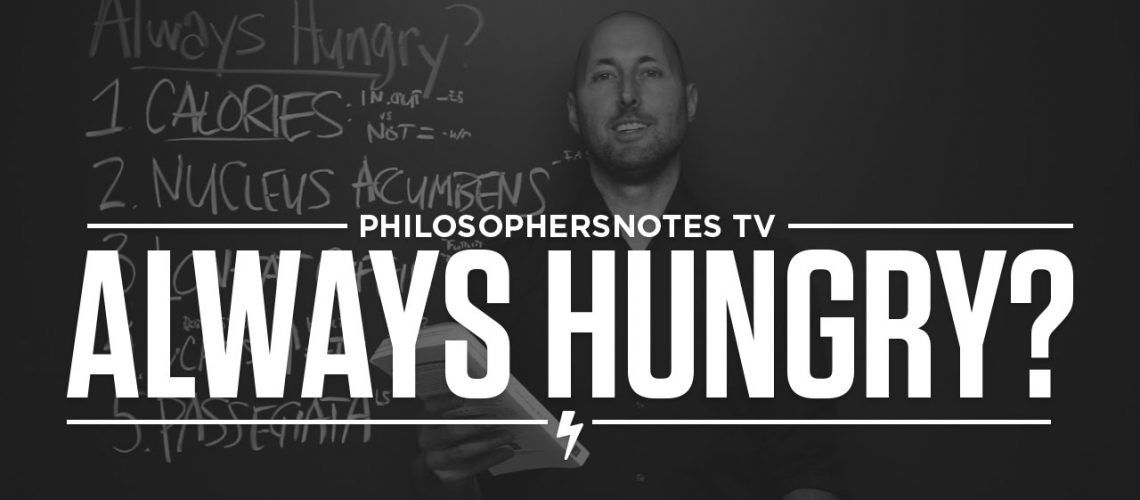Conquer Cravings, Retrain Your Fat Cells, and Lose Weight Permanently
Forget everything you’ve been taught about dieting. In the New York Times bestseller ALWAYS HUNGRY?, renowned endocrinologist Dr. David Ludwig explains why traditional diets don’t work, and presents a radical new plan to help you lose weight without hunger, improve your health, and feel great.
Video by Philosophers Notes TV
Key Takeaways
5 Big Ideas
1. Calories
One of the underlying themes of the book is challenging the prevalence notion of calories in, calories out.
You just need to balance how much you eat with how much you move. You need to eat less then you burn throughout the day. Calories in calories out— it’s called the energy balance hypothesis. He basically says that is false.
Calories are not all equal. If you go with the calories in, calories out model, you basically say that a calorie is a calorie, which is true in a vacuum in a lab—a calorie is a calorie—you can measure the amount of energy created. But our human bodies are not a vacuum and when you put a calorie into your body the quality of that calorie matters. It affects your hormones, and metabolism, so there’s a counter to the energy balance hypothesis.
This is called the hormonal or metabolic hypothesis, which says calories are not count are not created equally. Different calories have different effects on your body. For example, highly processed carbs have a very significant, very negative impact on your body. This isn’t even real food that we’re eating these days. Realize that the quality of your calories matters a lot.
2. Nucleus Accumbens
Study showed that individuals that ate fast-acting carbs had a part of their brain connected to the reward center an addiction called the nucleus accumbens light up like a laser. The group that ate slow-acting carbs were put in an fMRI, and there was no activity in the reward center.
The group that had the fast-acting carbs, and the reward center lights up. This is the source of cravings, this is the source of addiction. The same centers light up when we’re talking about other addiction—addictive substances like alcohol, cocaine, etc..
Not only is blood sugar going up and then dropping when eating highly processed carbohydrates, but we’re also triggering the addiction and reward centers in our brain. This makes it really difficult to sustain a healthy brain if you’re consuming a ton of refined carbs.
3. Low-Fat Coffin
Two different research studies shows that high fat diets exceedingly outperform the low fat diets. It was unethical to continue the experiments. The last forty years as we have adopted this low-fat approach and demonized fat, we’ve seen our weight in the USA go up by about 17 pounds for the average man, and 19 pounds for the average woman.
4. Carbs Down, Healthy Fats Up
First half of the book is science. Second half of the book is a three-phase plan to conquer your cravings, retrain your fat cells and the phase three is to keep your weight off permanently.
Phase One: Conquer Cravings reduce your processed carbs to zero. Remove grains in the first phase and of course all the other processed carbohydrates then in
Phase Two: Retrain Your Fat Cells after a couple of weeks you can reintegrate the grains etc. Test that over two to six months and then you adopt your own little bio individual plan. Basically you swap out your processed carbs for healthy fats. (olive oil avocado, nuts, etc…) You’ll find a pleasant level of satiety that you don’t get when you’re eating highly processed carbs.
Highly processed carbs are stimulating your reward center, they’re making you crave more and they’re making a hungrier. They’re not satisfying you the way that fats do, so his whole point throughout this book: A. eat healthy fat and lose weight, and B. I’m not hungry. I feel good, which most people don’t feel on most of the programs that restrict calories.
This is another reason why it doesn’t work you restrict calories to lose weight. Sure you’ll lose weight quickly, but then what happens is your hunger increases while your metabolism slows..(When you’re doing the calories in and out approach, and restricting calories.) This is not a winning combination because then you are going to eat more with the slow metabolism, and put on more weight.
5. Passeggiata
Reintroduce a Passeggiata to your daily routine. A leisurely walk or stroll, especially one taken in the evening; that many Italians do.
In addition to changing your nutrition you want to also make sure you’re managing your stress well, you’re moving consistently and you’re sleeping well. Create a big WHY. Why do you want to do this? Create IF THEN planning.
- Research shows that older adults who were at risk for diabetes, went on three 15-minute walks after their meals, and research showed that it helped them with their insulin, and with their overall metabolism.
- The fact that three one-mile walks are better than one three.
- Finding the time to move your DNA helps not only optimizing of your genetic expression, but also your insulin, and everything else.
- Schedule walks into life—try five mini walks a day—can be as short as 3-5 minutes, for 10 minutes, then some longer ones but have fun getting your walk on after your meals.


